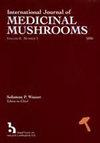Impact of Substrate Disinfection on Yield and Efficiency of Drying Methods for Quality Preservation of Elm Oyster Mushroom Hypsizygus ulmarius (Agaricomycetes) and Its Medicinal Value
IF 1.4
4区 生物学
Q4 MYCOLOGY
International journal of medicinal mushrooms
Pub Date : 2024-02-01
DOI:10.1615/intjmedmushrooms.2024052836
引用次数: 0
Abstract
This paper evaluated the effect of different substrate disinfection methods viz. hot water treatment, autoclaving and steam pasteurization at 100°C, 121°C and 65°C respectively on yield of Hypsizygus ulmarius and effects of sun drying, oven drying and cabinet drying techniques at 25±2°C, 40±2°C and 50±2°C respectively on nutritional qualities of H. ulmarius. Hot water treated substrate gave higher yield (215.36±1.49 g) and biological efficiency (71.78 %) as compared to autoclaved (194.45±3.36 g and 64.81 %) and steam pasteurized substrate (194.45±3.36 g and 65 .28 %). The different drying methods used for drying the fruit bodies significantly influenced the nutrient profile of H. ulmarius. Highest moisture (6.95 %), fiber (16.94 %) and protein content (22.49 %) was retained in sun dried fruit bodies whereas ash content (5.52 %) was highest for oven dried fruit bodies. Cabinet dried fruit bodies showed significantly higher percentage of fats (1.82 %) and carbohydrates (53.58 %). In the DPPH assay the cabinet dried fruit bodies showed the highest antioxidant activity followed by sun dried and oven dried fruit bodies with respective IC50 values as 104.21±0.14, 117.17±0.07 and 163.57±0.02. The drying methods proved to be effective in controlling the bacterial growth for a period of two months after which significant bacterial growth was noted.基质消毒对榆蚝姬松茸(姬松茸属)产量和干燥方法保质效率的影响及其药用价值
本文评估了不同基质消毒方法(即分别在 100°C、121°C 和 65°C 下进行热水处理、高压灭菌和蒸汽巴氏灭菌)对溃疡苣苔产量的影响,以及分别在 25±2°C、40±2°C 和 50±2°C 下进行日光干燥、烘箱干燥和柜式干燥技术对溃疡苣苔营养品质的影响。热水处理基质的产量(215.36±1.49 克)和生物效率(71.78 %)高于高压灭菌(194.45±3.36 克和 64.81 %)和蒸汽巴氏灭菌(194.45±3.36 克和 65.28 %)。不同的干燥方法对果实营养成分的影响很大。晒干的果体水分(6.95 %)、纤维(16.94 %)和蛋白质含量(22.49 %)最高,而烘干的果体灰分含量(5.52 %)最高。柜烘干果体的脂肪(1.82 %)和碳水化合物(53.58 %)含量明显较高。在 DPPH 试验中,柜式干燥果体的抗氧化活性最高,其次是晒干果体和烘干果体,IC50 值分别为 104.21±0.14、117.17±0.07 和 163.57±0.02。事实证明,这些干燥方法能有效控制细菌的生长,两个月后细菌生长明显。
本文章由计算机程序翻译,如有差异,请以英文原文为准。
求助全文
约1分钟内获得全文
求助全文
来源期刊
CiteScore
2.60
自引率
16.70%
发文量
91
审稿时长
6-12 weeks
期刊介绍:
The rapid growth of interest in medicinal mushrooms research is matched by the large number of disparate groups that currently publish in a wide range of publications. The International Journal of Medicinal Mushrooms is the one source of information that will draw together all aspects of this exciting and expanding field - a source that will keep you up to date with the latest issues and practice. The International Journal of Medicinal Mushrooms published original research articles and critical reviews on a broad range of subjects pertaining to medicinal mushrooms, including systematics, nomenclature, taxonomy, morphology, medicinal value, biotechnology, and much more.

 求助内容:
求助内容: 应助结果提醒方式:
应助结果提醒方式:


